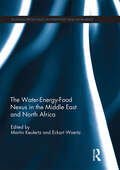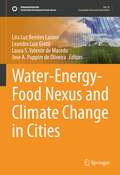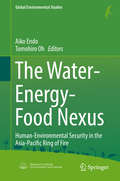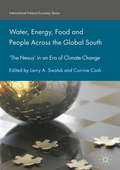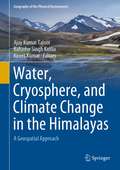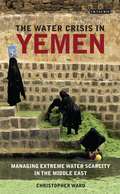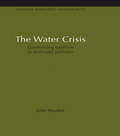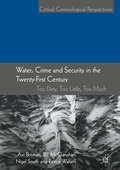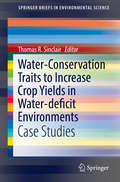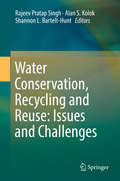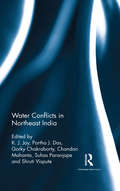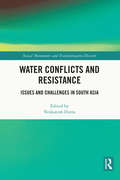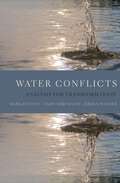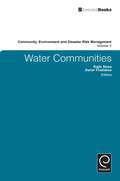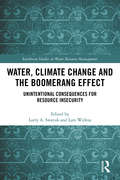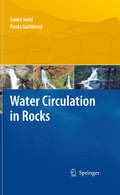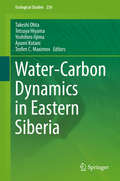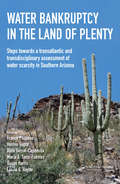- Table View
- List View
The Water-Energy-Food Nexus in the Middle East and North Africa (Routledge Special Issues on Water Policy and Governance)
by Martin Keulertz Eckart WoertzThis book discusses key issues concerning water, energy and food in the Middle East and North Africa (MENA) region. It provides an interdisciplinary account of current developments in the most water-scarce and conflict-torn region in the world. Key analysts on MENA water, agriculture and energy affairs have been drawn together to compile one of the first edited volumes dedicated to the crucial role of water, energy and food security in the 21st century MENA region. It will be of interest to decision-makers, analysts and students of the future of the Middle East from a broad range of disciplines including the physical and social sciences. This book was previously published as a special issue of the International Journal of Water Resources Development.
The Water-Energy-Food Nexus in the Middle East and North Africa (Routledge Special Issues on Water Policy and Governance)
by Martin Keulertz Eckart WoertzThis book discusses key issues concerning water, energy and food in the Middle East and North Africa (MENA) region. It provides an interdisciplinary account of current developments in the most water-scarce and conflict-torn region in the world. Key analysts on MENA water, agriculture and energy affairs have been drawn together to compile one of the first edited volumes dedicated to the crucial role of water, energy and food security in the 21st century MENA region. It will be of interest to decision-makers, analysts and students of the future of the Middle East from a broad range of disciplines including the physical and social sciences. This book was previously published as a special issue of the International Journal of Water Resources Development.
Water-Energy-Food Nexus and Climate Change in Cities (Sustainable Development Goals Series)
by Lira Luz Benites Lazaro Leandro Luiz Giatti Laura S. Valente de Macedo Jose A. Puppim de OliveiraThis book aims to contribute to the transdisciplinary study of the water-energy-food (WEF) nexus in cities and to help policy makers adopt a more integrated approach to natural resources management in urban environments to face the challenges and threats of climate change. This approach is based on a multidimensional scientific framework that seeks to understand the complex and non-linear interrelationships and interdependencies between water-energy-food under climate change and to generate solutions to reduce trade-offs among development goals and generate co-benefits that help encourage sustainable development and contribute to the achievement of SDGs, mainly SDG 11 (make cities and human settlements inclusive, safe, resilient and sustainable) and SDG 13 (take urgent action to combat climate change and its impacts).Governing the WEF nexus in cities is one of the greatest resource challenges of our time, as cities consume large amounts of WEF, but one that can also generate relevant alternatives with which to tackle climate change. To help fostering these alternatives, this book analyzes the governance, institutional and political economy factors that determine the effectiveness of the nexus approach and reviews the potential, the benefits and the policy implications of the adoption of the WEF nexus approach at the urban level. Through a series of hands-on cases, chapters in this book present the opportunities of the WEF nexus approach to achieve innovation and transformative change and discuss concrete areas of synergy and policy initiative to raise urban resilience. Water-Energy-Food Nexus and Climate Change in Cities will serve both as a guide for policy makers as well as a useful resource for students and researchers in fields such as urban studies, public health, environmental sciences, energy studies and public policy interested in learning how cities can represent possibilities to navigate and manage sustainability from local to global.
The Water-Energy-Food Nexus: Human-Environmental Security in the Asia-Pacific Ring of Fire (Global Environmental Studies)
by Aiko Endo Tomohiro OhThis book highlights the water-energy-food nexus as one of the most important and fundamental global environmental issues facing the world. Climate and social changes are putting increased pressure on water, energy and food resources. As water is the central aspect within this cluster, the book focuses on the inherent tradeoffs in water resources between producing/consuming energy and food. In addition, it discusses an inter- and trans-disciplinary approach to understanding the complexity of the water-energy-food nexus system, and creating policy options to reduce the tradeoffs among resources. The content integrates a variety of academic disciplines, including not only the natural sciences (e.g. hydrology, coastal oceanography, costal aquatic bioscience, fisheries, environmental earth science etc.) but also the humanities and social sciences (e.g. marine policy, environmental energy policy, resource governance, policy process theory etc.). The book can be used as a textbook for undergraduate and graduate-level sustainability science courses. Further, its practical content and trans-disciplinary approach to addressing nexus issues with stakeholders offers vital information for practitioners and administrators alike.
Water, Energy, Food and People Across the Global South
by Larry A. Swatuk Corrine CashThis collection critically engages the resource use nexus. Clearly, a nexus-approach to resource policy, planning and practice is essential if sustainable development goals are to be met. In particular, in an era of climate change, an integrated approach to water, energy and agriculture is imperative. Agriculture accounts for 70% of global water withdrawals, food production accounts for 30% of global energy use and a rising global population requires more of everything. As shown in this collection, scholars of resource development, governance and management are 'nexus sensitive', utilizing a sort of 'nexus sensibility' in their work as it focuses on the needs of people particularly, but not only, in the global South. Importantly, a nexus-approach presents academics and practitioners with a discursive space in which to shape policy through research, to deepen and improve understandings of the interconnections and impacts of particular types of resource use, and to critically reflect on actions taken in the name of the 'nexus'.
Water, Energy, Food and People Across the Global South: ‘The Nexus’ in an Era of Climate Change
by Larry A. Swatuk Corrine CashThis collection critically engages the resource use nexus. Clearly, a nexus-approach to resource policy, planning and practice is essential if sustainable development goals are to be met. In particular, in an era of climate change, an integrated approach to water, energy and agriculture is imperative. Agriculture accounts for 70% of global water withdrawals, food production accounts for 30% of global energy use and a rising global population requires more of everything. As shown in this collection, scholars of resource development, governance and management are ‘nexus sensitive’, utilizing a sort of ‘nexus sensibility’ in their work as it focuses on the needs of people particularly, but not only, in the global South. Importantly, a nexus-approach presents academics and practitioners with a discursive space in which to shape policy through research, to deepen and improve understandings of the interconnections and impacts of particular types of resource use, and to critically reflect on actions taken in the name of the ‘nexus’.
Water, Cryosphere, and Climate Change in the Himalayas: A Geospatial Approach (Geography of the Physical Environment)
by Ajay Kumar Taloor Bahadur Singh Kotlia Kireet KumarThis edited book summarizes numerous research studies on remote sensing and GIS of natural resource management for the Himalaya region done by Indian Institutions and Universities over the last decade. It gives an overview of hydrometeorological studies on Himalayan water resources and addresses concerns in the development of water resources in this region, which is dealing with an increased pressure in population, industrialization and economic development. While the source of some of the major rivers of India are found in the Himalayas, the glaciers and water bodies in the region are continuously shrinking leading to a depletion of water and deterioration of water quality. This is affecting a population of up to 2.5 billion people. The ecosystems have been under threat due to deforestation, loss of biodiversity, expansion of agriculture and settlement, overexploitation of natural resources, habitat loss and fragmentation, poaching, mining, construction of roads and large dams, and unplanned tourism. Spaceborne remote sensing with its ability to provide synoptic and repetitive coverage has emerged as a powerful tool for assessment and monitoring of the Himalayan resources and phenomena. This work serves as a resource to students, researchers, scientists, professionals, and policy makers both in India and on a global level.
The Water Crisis in Yemen: Managing Extreme Water Scarcity in the Middle East (International Library of Human Geography)
by Christopher WardSince the 1970s Yemen has undergone rapid social and economic change. But the creation of the modern state has come at a cost, and the country has fallen into a severe water crisis. Groundwater is being extracted at such a rate that parts of the rural economy could disappear within a generation. In no other country in the Middle East are the aquifers being exhausted so quickly. Christopher Ward provides the first comprehensive study of the water management crisis in Yemen and presents a complete analysis, covering the institutional, environmental, technical and political economy components. He assesses the social and economic impacts of the crisis and provides in-depth case studies in the key management areas: water resources management; agricultural water management and irrigation; urban water supply and sanitation; and rural water supply and sanitation. He examines the range of policy and programme responses to date and explores their largely unsuccessful outcomes. In the final part of the book the author evaluates the current strategy and looks at future ways in which the people of the country and their government can influence outcomes and make the transition to a sustainable water economy. Combining a historical perspective and an interdisciplinary approach, The Water Crisis in Yemen draws on both new field research and a very wide set of official and unofficial information sources, much of it being made available for the first time. The result offers a comprehensive, practical and effective approach to achieving sustainable and equitable water management in a country whose water problems are amongst the most serious in the world.
The Water Crisis: Constructing solutions to freshwater pollution
by Julie StaufferModern society too often views water as a convenient vehicle for disposing of waste � and the results are becoming increasingly apparent. Analysis of freshwater supplies frequently reveals disturbing levels of pollution, including human waste, heavy metals and synthetic chemicals, to the detriment of our health, and the health of entire ecosystems. The Water Crisis examines the roots of freshwater pollution � urbanization, industrialization and intensive farming � supported by case studies from the Rhine and the Great Lakes. It explores the impact of major pollutants and discusses methods of prevention. The final section provides a detailed overview of possible solutions, including soil-based treatment systems and constructed wetlands. A separate chapter is devoted to the important issue of groundwater pollution. Practical concise and accessible, this is ideal for students in environmental studies and environmental science, biology and geography, and general readers. Originally published in 1998
The Water Crisis: Constructing solutions to freshwater pollution (Natural Resource Management Set Ser.)
by Julie StaufferModern society too often views water as a convenient vehicle for disposing of waste � and the results are becoming increasingly apparent. Analysis of freshwater supplies frequently reveals disturbing levels of pollution, including human waste, heavy metals and synthetic chemicals, to the detriment of our health, and the health of entire ecosystems. The Water Crisis examines the roots of freshwater pollution � urbanization, industrialization and intensive farming � supported by case studies from the Rhine and the Great Lakes. It explores the impact of major pollutants and discusses methods of prevention. The final section provides a detailed overview of possible solutions, including soil-based treatment systems and constructed wetlands. A separate chapter is devoted to the important issue of groundwater pollution. Practical concise and accessible, this is ideal for students in environmental studies and environmental science, biology and geography, and general readers. Originally published in 1998
Water, Crime and Security in the Twenty-First Century: Too Dirty, Too Little, Too Much (Critical Criminological Perspectives )
by Avi Brisman Nigel South Reece Walters Bill McClanahanCritical Criminological Perspectives Ser.
Water-Conservation Traits to Increase Crop Yields in Water-deficit Environments: Case Studies (SpringerBriefs in Environmental Science)
by Thomas R. SinclairThis volume explores specific approaches that have shown to result in crop yield increases. Research on the physiological understanding of these methods has led to the development of practical applications of plant breeding approaches to genetically improve crops to achieve higher yields. Authoritative entries from crop scientists shed new light on two water-conservation traits: one that is based on an initiation of the decrease in transpiration earlier in the soil drying cycle, and the second that is based on a sensitivity of transpiration rate under high atmospheric vapor pressure deficit that results in partial stomatal closure. Both these approaches involve partial stomatal closure under well-defined situations to decrease the rate of soil water loss. Readers will be able to analyze the circumstances under which a benefit is achieved as a result of the water-limitation trait; and key discussion points in the case studies presented will help answer questions such as what species, which environments, how often will yield be benefited for various crop species? Contributions also review the genetic variation for these two traits within each crop species and the physiological basis for the expression of these traits.
Water Conservation, Recycling and Reuse: Issues and Challenges
by Rajeev Pratap Singh Alan S. Kolok Shannon L. Bartelt-HuntWater - a basic element of life, livelihood, food security and sustainable development - holds the key to global sustainability. The global water demand has been increased 3-fold in the past five decades and only 0.4% of the total world’s fresh water resources is available and accessible for use. The United Nations projected that half of all countries will face water scarcity by 2025 and more than one-third of the world’s population could be affected by water stress by 2050. The water problem is rapidly intensifying in the Asian region, and around 700 million people do not have access to safe drinking water. Similarly, according to the Intergovernmental Panel on Climate Change (IPCC) report, by 2050, more than one billion people in Asia alone are projected to experience negative impacts on water resources as a result of climate change. Climate change is also putting extra pressure on and adversely affecting the global water cycle, leading to irregular precipitation, more floods and droughts and creating an imbalance between water supply and demand. The availability of safe water is a major global concern due to the rapidly increasing population, urbanization, unsustainable consumption patterns, and rapid shifts in land use. It is believed that reduced access to freshwater will have cascading consequences that will pose threat to global food security, livelihood security, and cause large scale migration and economic and geopolitical tensions. As such, strategies for water conservation, wastewater reuse and recycling should be adopted in order to lessen the gap between supply and demand for water for different activities. This book provides readers with a better understanding of the water security challenges, and presents innovations to address these challenges, strengthen the science-policy interface, and develop institutional and human capacities for water security and sustainability.
Water Conflicts in Northeast India
by K. J. Joy Partha J. Das Gorky Chakraborty Chandan Mahanta Suhas Paranjape Shruti VisputeNortheast India, apart from being the rainiest in India, is drained by two large river systems of the world – the Brahmaputra and the Barak (Meghna) – both transnational rivers cutting across bordering countries. The region, known for its rich water resources, has been witnessing an increasing number of conflicts related to water in recent years. This volume documents the multifaceted conflicts and contestations around water in Northeast India, analyses their causes and consequences, and includes expert recommendations. It fills a major gap in the subject by examining wide-ranging issues such as cultural and anthropological dimensions of damming rivers in the Northeast and Eastern Himalayas; seismic surveys, oil extractions, and water conflicts; discontent over water quality and drinking water; floods, river bank erosion, embankments; water policy; transboundary water conflicts; and hydropower development. It also discusses the alleged Chinese efforts to divert the Brahmaputra River. With its analytical and comprehensive coverage, 18 case studies, and suggested approaches for conflict resolution, this book will be indispensable for scholars and researchers of development studies, governance and public policy, politics and international relations, water resources, environment, geography, climate change, area studies, economics, and sociology. It will also be an important resource for policymakers, bureaucrats, development practitioners, civil society groups, the judiciary, and media.
Water Conflicts in Northeast India
by K. J. Joy Partha J. Das Gorky Chakraborty Chandan Mahanta Suhas Paranjape Shruti VisputeNortheast India, apart from being the rainiest in India, is drained by two large river systems of the world – the Brahmaputra and the Barak (Meghna) – both transnational rivers cutting across bordering countries. The region, known for its rich water resources, has been witnessing an increasing number of conflicts related to water in recent years. This volume documents the multifaceted conflicts and contestations around water in Northeast India, analyses their causes and consequences, and includes expert recommendations. It fills a major gap in the subject by examining wide-ranging issues such as cultural and anthropological dimensions of damming rivers in the Northeast and Eastern Himalayas; seismic surveys, oil extractions, and water conflicts; discontent over water quality and drinking water; floods, river bank erosion, embankments; water policy; transboundary water conflicts; and hydropower development. It also discusses the alleged Chinese efforts to divert the Brahmaputra River. With its analytical and comprehensive coverage, 18 case studies, and suggested approaches for conflict resolution, this book will be indispensable for scholars and researchers of development studies, governance and public policy, politics and international relations, water resources, environment, geography, climate change, area studies, economics, and sociology. It will also be an important resource for policymakers, bureaucrats, development practitioners, civil society groups, the judiciary, and media.
Water Conflicts and Resistance: Issues and Challenges in South Asia (Social Movements and Transformative Dissent)
by Venkatesh DuttaThis book presents a systematic study of transboundary, regional and local water conflicts and resistance across several river basins in South Asia. Addressing hydro-socio-economic aspects in competing water sharing and transfer agreements, as well as conflicting regimes of legal plurality, property rights and policy implementation, it discusses themes such as rights over land and natural resources; resettlement of dam-displaced people; urban–rural conflicts over water allocation; peri-urbanisation, land use conflicts and water security; tradeoffs and constraints in restoration of ecological flows in rivers; resilience against water conflicts in a river basin; and irrigation projects and sustainability of water resources. Bringing together experts, professionals, lawyers, government and the civil society, the volume analyses water conflicts at local, regional and transboundary scales; reviews current debates with case studies; and outlines emerging challenges in water policy, law, governance and institutions in South Asia. It also offers alternative tools and frameworks of water sharing mechanisms, conflict resolution, dialogue, and models of cooperation and collaboration for key stakeholders towards possible solutions for effective, equitable and strategic water management. This book will be useful to scholars and researchers of development studies, environment studies, water studies, public policy, political science, international relations, conflict resolution, political economy, economics, sociology and social anthropology, environmental law, governance and South Asian studies. It will also benefit practitioners, water policy thinktanks and associations, policymakers, diplomats and NGOs.
Water Conflicts and Resistance: Issues and Challenges in South Asia (Social Movements and Transformative Dissent)
by Venkatesh DuttaThis book presents a systematic study of transboundary, regional and local water conflicts and resistance across several river basins in South Asia. Addressing hydro-socio-economic aspects in competing water sharing and transfer agreements, as well as conflicting regimes of legal plurality, property rights and policy implementation, it discusses themes such as rights over land and natural resources; resettlement of dam-displaced people; urban–rural conflicts over water allocation; peri-urbanisation, land use conflicts and water security; tradeoffs and constraints in restoration of ecological flows in rivers; resilience against water conflicts in a river basin; and irrigation projects and sustainability of water resources. Bringing together experts, professionals, lawyers, government and the civil society, the volume analyses water conflicts at local, regional and transboundary scales; reviews current debates with case studies; and outlines emerging challenges in water policy, law, governance and institutions in South Asia. It also offers alternative tools and frameworks of water sharing mechanisms, conflict resolution, dialogue, and models of cooperation and collaboration for key stakeholders towards possible solutions for effective, equitable and strategic water management. This book will be useful to scholars and researchers of development studies, environment studies, water studies, public policy, political science, international relations, conflict resolution, political economy, economics, sociology and social anthropology, environmental law, governance and South Asian studies. It will also benefit practitioners, water policy thinktanks and associations, policymakers, diplomats and NGOs.
Water Conflicts: Analysis for Transformation
by Mark Zeitoun Naho Mirumachi Jeroen WarnerWater Conflicts applies cutting-edge thinking to identify pathways that can transform complex water conflicts. It challenges existing power-blind and politics-lite analysis that is very deeply-held and recurring in debates that suggest causal links between scarcity and violence-or peace. This book presents a much needed revision of transboundary water analysis, leading to a rethink on the way water is used and contested, with a focus on harm experienced both by the most vulnerable water users and the environment. Recognizing that conflicts are never static, Mark Zeitoun, Naho Mirumachi, and Jeroen Warner's "transformative analysis" provides multi-disciplinary tools and perspectives to understand and address the complexities involved. The approach is stress-tested through dozens of examples around the globe, and it incorporates collective evidence and knowledge of the London Water Research Group. The insights on water diplomacy will be most welcome by analysts, activists, diplomats, and all others tackling water conflicts. Seeking to motivate improvement of transboundary water arrangements towards further equity and sustainability as a practical agenda, the book is a fresh antidote to the detached role that researchers and policymakers often play.
Water Conflicts: Analysis for Transformation
by Mark Zeitoun Jeroen Warner Naho MirumachiWater Conflicts applies cutting-edge thinking to identify pathways that can transform complex water conflicts. It challenges existing power-blind and politics-lite analysis that is very deeply-held and recurring in debates that suggest causal links between scarcity and violence-or peace. This book presents a much needed revision of transboundary water analysis, leading to a rethink on the way water is used and contested, with a focus on harm experienced both by the most vulnerable water users and the environment. Recognizing that conflicts are never static, Mark Zeitoun, Naho Mirumachi, and Jeroen Warner's "transformative analysis" provides multi-disciplinary tools and perspectives to understand and address the complexities involved. The approach is stress-tested through dozens of examples around the globe, and it incorporates collective evidence and knowledge of the London Water Research Group. The insights on water diplomacy will be most welcome by analysts, activists, diplomats, and all others tackling water conflicts. Seeking to motivate improvement of transboundary water arrangements towards further equity and sustainability as a practical agenda, the book is a fresh antidote to the detached role that researchers and policymakers often play.
Water Communities (Community, Environment and Disaster Risk Management #2)
by Rajib Shaw Danai Thaitakoo Hari SrinivasWater is the key to human civilization. Most of the ancient civilization had its roots to river basins, where people-water interaction was the key aspect. Due to innovations of knowledge and technology and modernization of lifestyles, the human-water direct contact has become less significant. People have become more dependent to the system, and consequently, the closeness to water is gradually diminishing. It is however, a challenge on how to learn from the basic principles of water human interaction and apply those lessons to the current context of urban and rural settings. This book will provide a few analytical case studies on different aspects of water communities, which is defined as the human-water interaction process.
Water, Climate Change and the Boomerang Effect: Unintentional Consequences for Resource Insecurity (Earthscan Studies in Water Resource Management)
by Larry A. Swatuk Lars WirkusIn line with COP21 agreements, state-led climate change mitigation and adaptation actions are being undertaken to transition to carbon-neutral, green economies. However, the capacity of many countries for action is limited and may result in a ‘boomerang effect’, defined as the unintended negative consequences of such policies and programmes on local communities and their negative feedbacks on the state. To avoid this effect, there is a need to understand the policy drivers, decision-making processes, and impacts of such action, in order to determine the ways and means of minimizing negative effects and maximizing mutually beneficial policy outcomes. This book directly engages the policy debates surrounding water resources and climate actions through both theoretical and comparative case studies. It develops the ‘boomerang effect’ concept and sets it in relation to other conceptual tools for understanding the mixed outcomes of state-led climate change action, for example ‘backdraft’ effect and ‘maldevelopment’. It also presents case studies illustrative of the consequences of ill-considered state-led policy in the water sector from around the world. These include Africa, China, South Asia, South America, the Middle East, Turkey and Vietnam, and examples of groundwater, hydropower development and forest hydrology, where there are often transboundary consequences of a state's policies and actions. In this way, the book adds empirical and theoretical insights to a still developing debate regarding the appropriate ways and means of combating climate change without undermining state and social development.
Water, Climate Change and the Boomerang Effect: Unintentional Consequences for Resource Insecurity (Earthscan Studies in Water Resource Management)
by Larry Swatuk Lars WirkusIn line with COP21 agreements, state-led climate change mitigation and adaptation actions are being undertaken to transition to carbon-neutral, green economies. However, the capacity of many countries for action is limited and may result in a ‘boomerang effect’, defined as the unintended negative consequences of such policies and programmes on local communities and their negative feedbacks on the state. To avoid this effect, there is a need to understand the policy drivers, decision-making processes, and impacts of such action, in order to determine the ways and means of minimizing negative effects and maximizing mutually beneficial policy outcomes. This book directly engages the policy debates surrounding water resources and climate actions through both theoretical and comparative case studies. It develops the ‘boomerang effect’ concept and sets it in relation to other conceptual tools for understanding the mixed outcomes of state-led climate change action, for example ‘backdraft’ effect and ‘maldevelopment’. It also presents case studies illustrative of the consequences of ill-considered state-led policy in the water sector from around the world. These include Africa, China, South Asia, South America, the Middle East, Turkey and Vietnam, and examples of groundwater, hydropower development and forest hydrology, where there are often transboundary consequences of a state's policies and actions. In this way, the book adds empirical and theoretical insights to a still developing debate regarding the appropriate ways and means of combating climate change without undermining state and social development.
Water Circulation in Rocks
by Laura Scesi Paola GattinoniUnderstanding water circulation in rocks represents a very important element to solving many of the problems linked with civil, environmental and mining engineering. This book offers a synthesis of the actual knowledge about the fluid flow in rocks: - from the medium characterization and the structural geological survey to the generation of stereonets; - the evaluation of the hydrogeological parameters using either deterministic or probabilistic methodologies; - the evaluation of the preferential flow direction considering the change of the hydrogeological structures; - the methods and models used to simulate the flows. Three case studies are provided; water circulation and slope instability, hydrogeological risk linked with tunnelling, and hydrogeological risk linked with road construction.
Water-Carbon Dynamics in Eastern Siberia (Ecological Studies #236)
by Takeshi Ohta Tetsuya Hiyama Yoshihiro Iijima Ayumi Kotani Trofim C. MaximovThis book discusses the water and carbon cycle system in the permafrost region of eastern Siberia, Providing vitalin sights into how climate change has affected the permafrost environment in recent decades. It analyzes the relationships between precipitation and evapotranspiration, gross primary production and runoff in the permafrost regions, which differ from those intropical and temperate forests. Eastern Siberia is located in the easternmost part of the Eurasian continent, and the land surface with underlying permafrost has developed over a period of seventy thousand years. The permafrost ecosystem has specific hydrological and meteorological characteristics in terms of the water and carbon dynamics, and the current global warming and resulting changes in the permafrost environment are serious issues in the high-latitude regions. The book is a valuable resource for students, researchers and professionals interested in forest meteorology and hydrology, forest ecology, and boreal vegetation, as well as the impact of climate change and water-carbon cycles in permafrost and non-permafrost regions.
Water Bankruptcy in the Land of Plenty (IHE Delft Lecture Note Series)
by Franck Poupeau Hoshin Gupta Aleix Serrat-Capdevila Maria A. Sans-Fuentes László G. HaydeAs the American Southwest faces its deepest drought in history, this book explores the provocative notion of “water bankruptcy” with a view towards emphasizing the diversity and complexity of water issues in this region. It bridges between the narratives of growth and the strategies or policies adopted to pursue competing agendas and circumvent the inevitable. A window of opportunity provided by this current long-term drought may be used to induce change by dealing with threats that derive from imbalances between growth patterns and available resources, the primary cause of scarcity. A first of its kind, this book was developed through close collaboration of a broad range of natural scientists, social scientists, and resource managers from Europe and United States. It constitutes a collective elaboration of a transdisciplinary approach to unveiling the inner workings of how water was fought for, allocated and used in the American Southwest, with a focus on Arizona. Specifically, it offers an innovative scientific perspective that produces a critical diagnostic evaluation of water management, with a particular view to identifying risks for the Tucson region that is facing continuous urban sprawl and economic growth.
